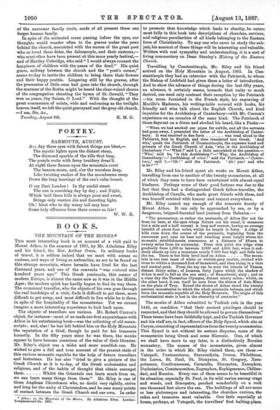RUSH-BEARING AT GRA SMERE.
fTo Tux EDITOR or Tar "Eirserwroa."]
Sm,—Tourists passing through Grasmere on Saturday last must have been surprised to see the low broad walls of the old grey church covered with masses of bright flowers woven into crosses and various emblematic forms ; while in the road beside the church were a crowd of spectators, mothers and fathers of the children who had brought the woven flowers, ladies and
gentlemen resident in Grasmere, and passing visitors, whose interest Was divided between the pretty display of flowers
standing like bright banners on the wall, and the party of merry children, who, having placed their offerings, were taking tea in a field by the side of the road. Many a tourist may have asked, "What is going on here ?" And the answer would be, "This is the Gra.smere rush-bearing."
Forty or fifty years ago, this" rush-bearing" was really what the word signifies, for rushes were every year gathered and borne to the church by children, to strew upon the earth floor of the church, in order to keep warm and dry the feet of the congregation. There are some now living in Grasmere who can remember the dry, rustling noise made by those who tried to draw the rushes comfortably and warmly round their feet. To-day this annual festival is one of remembrance and dedica- tion only ; instead of rushes, the children bring these floral decorations, which, after being placed on the wall, are in due time borne by the children in procession through the village, and then placed in the church.
These flower-emblems are curious and diverse in design. It is evidently en regle to bring the rash as much as possible into the decorations ; so we see a rush-basket full of carnations, a cross of rushes wreathed with scarlet geraniums, another covered with white lilies, a harp strung with reeds and twined with roses. This association of rushes must have governed power. fully the ingenious little mind of one who made a rush cradle- bed for a waxen baby, and called it "Moses in the bulrushes."
After tea was over, the children took their places beside the flowery standards, and then formed themselves into a proces- sion, each child bearing its flowers before it, and away they marched, a wayward, irregular, but most charming little pro- cession. There were children of all ages and sizes,—tall, slim little girls and boys, and mere toddling things who could not keep their places at all. There were two pretty babes in perambulators, and one little fellow rode triumphant, with a sceptre of lilies held before him. It is difficult to describe this village festival without speaking of the sympathetic and kindly feeling of those whose presence there was the inspiration of it all,—whose genial and generous kindness, escaping the bounds
of the narrower family circle, made of all present there one larger human family. In spite of the animated scene passing before the eyes, our thoughts would wander often to the graves under the yews behind the church, associated with the names of the great poet who so loved these dales, the dalespeople, and their customs,— who must often have been present at this same yearly festival,— and of Hartley Coleridge, who said "I would always connect the happiness of children with the peace of the dead." His quiet grave, midway between the church and the "poet's corner," seems to-day to invite the children to bring there their flowers and their happy prattle. Lingering still by the graves, after the procession of little ones had gone into the church, through the murmur of the Rotha might be heard the clear-voiced chorus of the congregation chanting the hymn of St. Oswald, "They won us peace, thy Saints, 0 Lord." With the thought of the great communion of saints, wide and embracing as the twilight heaven itself, we left the quiet graveyard and the grey old church. --I am, Sir, Ac.,



































 Previous page
Previous page